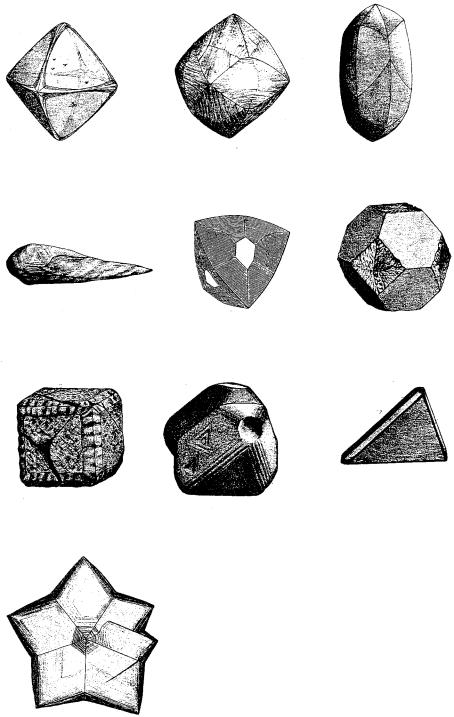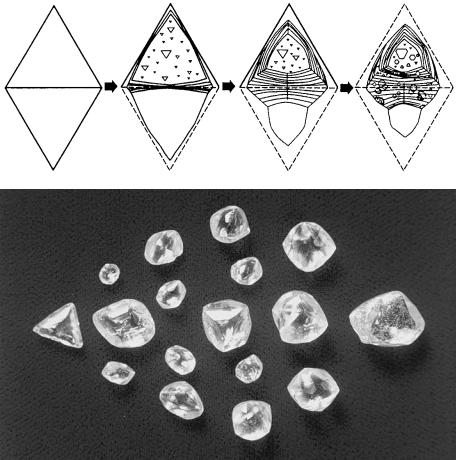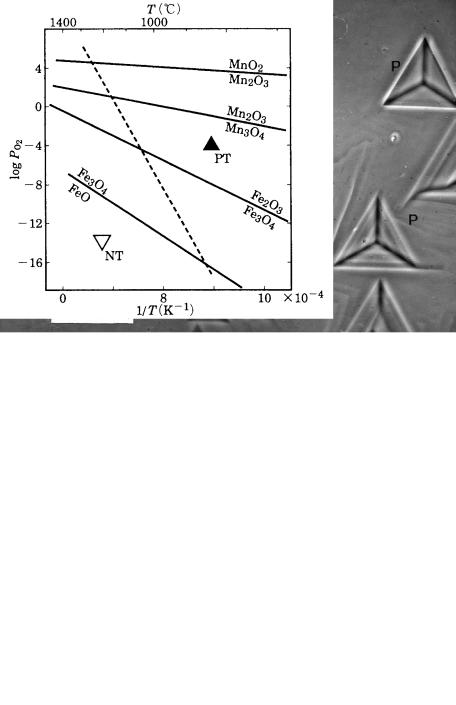
- •Contents
- •Foreword to the English translation
- •Preface
- •1 Introduction
- •1.1 Historical review
- •1.2 The birth of the concept of crystal growth
- •1.3 Morphology, perfection, and homogeneity
- •1.4 Complicated and complex systems
- •References
- •Suggested reading
- •2 Crystal forms
- •2.1 Morphology of crystals – the problems
- •References
- •Suggested reading
- •3 Crystal growth
- •3.1 Equilibrium thermodynamics versus kinetic thermodynamics
- •3.2 Driving force
- •3.3 Heat and mass transfer
- •3.4 Examples of mass transfer
- •3.6 Nucleation
- •3.7 Lattice defects
- •3.8 Interfaces
- •3.9 Spiral growth
- •3.10 Growth mechanism and morphology of crystals
- •3.11 Morphological instability
- •3.12 Driving force and morphology of crystals
- •3.13 Morphodroms
- •3.14 Element partitioning
- •3.15 Inclusions
- •References
- •Suggested reading
- •4 Factors determining the morphology of polyhedral crystals
- •4.1 Forms of polyhedral crystals
- •4.2 Structural form
- •4.3 Equilibrium form
- •4.4 Growth forms
- •4.4.1 Logical route for analysis
- •4.4.2 Anisotropy involved in the ambient phase
- •4.4.3 Whiskers
- •MAJOR FACTORS
- •METHODOLOGY
- •IMPURITIES
- •AMBIENT PHASES AND SOLVENT COMPONENTS
- •4.4.7 Factors controlling growth forms
- •References
- •Suggested reading
- •5 Surface microtopography of crystal faces
- •5.1 The three types of crystal faces
- •5.2 Methods of observation
- •5.3 Spiral steps
- •5.4 Circular and polygonal spirals
- •5.5 Interlaced patterns
- •5.6 Step separation
- •5.7 Formation of hollow cores
- •5.8 Composite spirals
- •5.9 Bunching
- •5.10 Etching
- •References
- •Suggested reading
- •6 Perfection and homogeneity of single crystals
- •6.1 Imperfections and inhomogeneities seen in single crystals
- •6.2 Formation of growth banding and growth sectors
- •6.3 Origin and spatial distribution of dislocations
- •References
- •7 Regular intergrowth of crystals
- •7.1 Regular intergrowth relations
- •7.2 Twinning
- •7.2.1 Types of twinning
- •7.2.2 Energetic considerations
- •7.2.4 Penetration twins and contact twins
- •7.2.5 Transformation twin
- •7.2.6 Secondary twins
- •7.3 Parallel growth and other intergrowth
- •7.4 Epitaxy
- •7.5 Exsolution, precipitation, and spinodal decomposition
- •References
- •Suggested reading
- •8 Forms and textures of polycrystalline aggregates
- •8.1 Geometrical selection
- •8.2 Formation of banding
- •8.3 Spherulites
- •8.4 Framboidal polycrystalline aggregation
- •References
- •Suggested reading
- •9 Diamond
- •9.1 Structure, properties, and use
- •9.2 Growth versus dissolution
- •9.3 Single crystals and polycrystals
- •9.4 Morphology of single crystals
- •9.4.1 Structural form
- •9.4.2 Characteristics of {111}, {110}, and {100} faces
- •9.4.3 Textures seen inside a single crystal
- •9.4.4 Different solvents (synthetic diamond)
- •9.4.5 Twins
- •9.4.6 Coated diamond and cuboid form
- •9.4.7 Origin of seed crystals
- •9.4.8 Type II crystals showing irregular forms
- •References
- •Suggested reading
- •10 Rock-crystal (quartz)
- •10.1 Silica minerals
- •10.2 Structural form
- •10.3 Growth forms
- •10.4 Striated faces
- •10.5 Growth forms of single crystals
- •10.5.1 Seed crystals and forms
- •10.5.2 Effect of impurities
- •10.5.3 Tapered crystals
- •10.6 Twins
- •10.6.1 Types of twins
- •10.6.2 Japanese twins
- •10.6.3 Brazil twins
- •10.7 Scepter quartz
- •10.8 Thin platy crystals and curved crystals
- •10.9 Agate
- •References
- •11 Pyrite and calcite
- •11.1 Pyrite
- •11.1.2 Characteristics of surface microtopographs
- •11.1.4 Polycrystalline aggregates
- •11.2 Calcite
- •11.2.1 Habitus
- •11.2.2 Surface microtopography
- •References
- •12 Minerals formed by vapor growth
- •12.1 Crystal growth in pegmatite
- •12.3 Hematite and phlogopite in druses of volcanic rocks
- •References
- •13 Crystals formed by metasomatism and metamorphism
- •13.1 Kaolin group minerals formed by hydrothermal replacement (metasomatism)
- •13.2 Trapiche emerald and trapiche ruby
- •13.3 Muscovite formed by regional metamorphism
- •References
- •14 Crystals formed through biological activity
- •14.1 Crystal growth in living bodies
- •14.2 Inorganic crystals formed as indispensable components in biological activity
- •14.2.1 Hydroxyapatite
- •14.2.2 Polymorphic minerals of CaCO3
- •14.2.3 Magnetite
- •14.3 Crystals formed through excretion processes
- •14.4 Crystals acting as possible reservoirs for necessary components
- •14.5 Crystals whose functions are still unknown
- •References
- •Appendixes
- •A.1 Setting of crystallographic axes
- •A.2 The fourteen Bravais lattices and seven crystal systems
- •A.3 Indexing of crystal faces and zones
- •A.4 Symmetry elements and their symbols
- •Materials index
- •Subject index
9.2 Growth versus dissolution 171
but they are also extremely valuable information transmitters of the conditions and events that have occurred in the depths of the Earth. There are many cases in which minerals formed in the mantle, deep within the Earth, are transported to the surface through global-scale movement such as plate tectonics, but most transform to other phases, decompose into more than two mineral species, or dissolve entirely. Although diamonds experience severe conditional changes, they do not transform into graphite, the low-pressure stable phase; instead, they survive in a metastable state, and thus can be a unique transmitter of information. In this way, information is recorded in the diamond crystals in the form of morphology, perfection, and homogeneity. It could be said that diamond is a unique letter sent from the depths of the Earth.
From geological and petrological investigations, and thermodynamic stability relations, it is believed that natural diamonds were formed deep under the Earth, under high-pressure, high-temperature conditions, then brought up to the Earth’s surface through rapid ascent of kimberlite and lamproite magmas, and were finally quenched as a metastable phase by adiabatic expansion due to volcanic eruption. From investigations of solid state inclusions in natural diamonds, two kinds of environmental compositions, ultramafic and eclogitic, have been distinguished. In addition, diamond crystals of micrometer size are found in garnet or zircon crystals in ultra-high-pressure metamorphic rocks.
We will explain in the following sections what new information may be obtained from morphology, perfection, and homogeneity in diamond crystals, in addition to the geological, geochemical, petrological, and mineralogical data.
9.2Growth versus dissolution
A total of 364 crystal figures of diamond are reproduced in Goldschmidt’s
Atlas der Kristallformen [1] published in 1913–23. The figures are beautiful sketches of crystals, and they even include surface microtopographs; some of these are shown in Fig. 9.2.
Although there are octahedral, dodecahedral, cubic, tetrahedral, elongated foot- ball-like forms, triangular platy forms, or star-like forms, the characteristic is that the forms are mostly rounded. Whether the rounded forms bounded by curved faces are due to growth or dissolution has been a subject of controversy since ancient times. Similar arguments arose about the origin of triangular depressions (trigons) universally observed on {111} faces with an opposite orientation to the triangle of the {111} faces, and on the origin of center-cross patterns seen in the center of octahedral crystals. The controversies surrounding these problems are summarized in Table 9.1.
The rounded forms of natural diamond crystals are commonly observed in crystals occurring both in alluvial deposits (secondary deposits) and in mother rocks

172 Diamond
Figure 9.2. Sketches of natural diamond crystals extracted from the Atlas der
Kristallformen [1].
|
9.2 Growth versus dissolution 173 |
|
Table 9.1 Growth versus dissolution controversies surrounding natural diamond crystals |
||
|
|
|
|
|
|
Origin of rounded forms |
|
|
Growth model |
solidification of liquid droplet of carbon, by Raman [3] |
|
Dissolution model |
Fersman and Goldschmidt [4], Williams [5], Seal [2] |
|
Origin of trigons |
|
|
Growth model |
Tolansky [6]; laboratory etching produces only etch pits of opposite |
|
|
orientation to trigons |
|
Dissolution model |
Frank [7]; etching in kimberlite powder produces trigons |
|
Center-cross pattern |
|
|
Growth model |
Frank [7]; combined form of smooth {111} and rough {100} faces |
|
Deformation model |
Tolansky [6]; due to plastic deformation |
|
|
|
|
|
|
|
(primary deposits), and so cannot be due to simple abrasion in the transporting process by water, but must be due to geological processes experienced during their growth or post-growth history.
Among the controversies summarized in Table 9.1, the argument that the rounded forms are due to growth and represent the as-grown morphology has been completely rejected, and it is now believed that all these forms represent the forms appearing due to the dissolution process.
As-grown crystals of diamond are bounded by flat faces, sharp edges, and corners, similar to ordinary polyhedral crystals. Conclusive evidence to support the dissolution process was obtained by Seal [2], who observed the relation between the rounded surfaces and growth banding revealed in crystals by etching the sections. From the observations showing that the rounded external form cuts the straight growth banding parallel to {111} seen in the interior, it was evident that the original crystal had been larger than its present size, and had changed its form to the present rounded form because the surface became partially dissolved (Fig. 6.1(c)).
As discussed previously, natural diamond crystals formed in the mantle deep within the Earth under high-temperature and high-pressure conditions corresponding to its thermodynamically stable region; they were then brought up to the Earth’s surface by magmatic movement of kimberlite and lamproite, and they eventually survived as a metastable phase due to adiabatic expansion by volcanic eruption. As diamonds ascend to the Earth’s surface, they have to pass through temperature and pressure conditions that can cause instability in diamond at high temperature. In addition, oxidation–reduction conditions vary according to the compositional differences in H2O and CO2 in different magmas, and the degree of dissolution will change depending on the oxygen fugacity, fO2.
Figure 9.3 is a schematic diagram showing how the morphology of the crystal and the surface microtopographs of crystal faces change as dissolution proceeds, starting from an as-grown octahedral crystal. The corner and edges of an

174Diamond
(a)
(b)
Figure 9.3. (a) Change of form as dissolution proceeds, starting from an octahedral
crystal. (b) Rounded crystals.
octahedral crystal are rounded, resulting in a hexa-octahedral form bounded by forty-eight rounded faces consisting of {hhl} faces. Etching also preferentially takes place at outcrops of dislocations and point defects on {111} faces, forming point-bottomed (P-type) and flat-bottomed (F-type) etch pits (trigons) (Fig. 9.4).
Trigons are, in general, oppositely orientated to the triangular form of a {111} face. In etching experiments in the laboratory using an oxidizing agent such as KNO3, it was only possible to produce etch pits with the same orientation as the triangular form of the {111} face. This led to arguments about whether the origin of trigons was due to growth or dissolution. It was shown experimentally that etch pits with the same orientation as naturally observed trigons were produced when diamonds were heated in powders of kimberlite. Later, it was demonstrated by Kanda et al. [8] that the orientations of etch pits of diamonds were reversed depending on the oxygen fugacity fO2 and the temperature T (Fig. 9.5).

9.2 Growth versus dissolution 175
Figure 9.4. P-type and F-type trigons. Phase contrast photomicrograph.
Figure 9.5. Orientations of trigons shown in relation to temperature T and oxygen fugacity fO2 [8]. PT has the same orientation as the triangle form of the {111} face, and NT has the opposite orientation.
